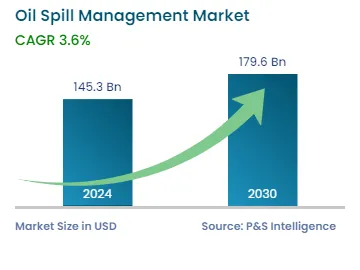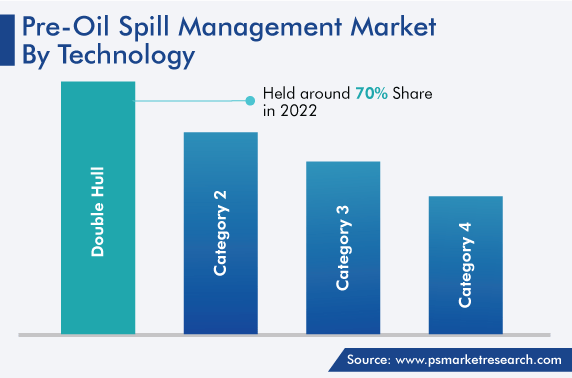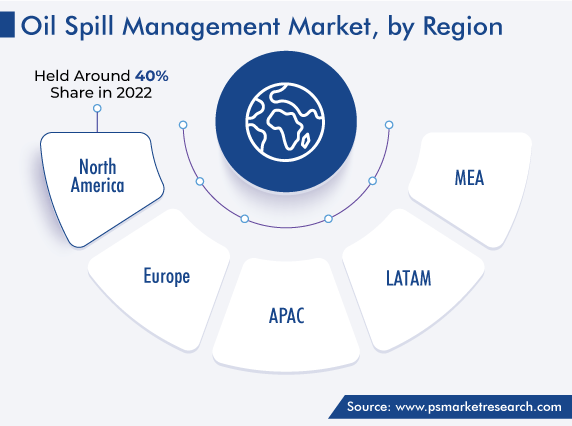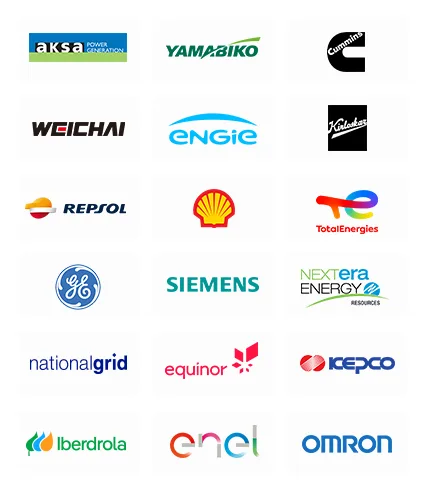Market Statistics
| Study Period | 2019 - 2030 |
| 2024 Market Size | USD 145.3 Billion |
| 2030 Forecast | USD 179.6 Billion |
| Growth Rate(CAGR) | 3.6% |
| Largest Region | North America |
| Fastest Growing Region | Asia-Pacific |
| Nature of the Market | Fragmented |
Report Code: 12649
Get a Comprehensive Overview of the Oil Spill Management Market Report Prepared by P&S Intelligence, Segmented by Technology (Pre-Oil Spill Management, Post-Oil Spill Management), Location (Onshore, Offshore), and Geographic Regions. This Report Provides Insights from 2019 to 2030.
| Study Period | 2019 - 2030 |
| 2024 Market Size | USD 145.3 Billion |
| 2030 Forecast | USD 179.6 Billion |
| Growth Rate(CAGR) | 3.6% |
| Largest Region | North America |
| Fastest Growing Region | Asia-Pacific |
| Nature of the Market | Fragmented |

Explore the market potential with our data-driven report
The oil spill management market size stood at USD 145.3 billion in 2024, and it is expected to exhibit a compound annual growth rate of 3.6% between 2024 and 2030, to reach USD 179.6 billion by 2030.
Oil spill management refers to the prevention and control of oil spread in the environment. Majorly, it involves the use of suitable pre-oil spill prevention techniques and post-spill cleaning strategies. It also includes the deployment of various technologies to reduce the disastrous ecological effects of spilt fuel. Oil can easily spill in waterbodies, such as oceans, streams, and bays, because of accidents involving tankers, drilling rigs, barges, refineries, pipelines, storage facilities, and recreational boats.
The market growth is ascribed to the surge in oil demand, rise in offshore drilling activities, stringent government norms and regulations for oil companies, and strong environmental concerns.
The need to control oil spillage incidence worldwide is bolstering the demand for mechanical containment and recovery methods. As per several published sources, in 2022, three large spills of more than 700 tons, two of which occurred in Asia and one in Africa, were recorded. Additionally, four medium-volume spills occurred in North America, Asia, and Africa due to collision/allision, grounding, hull failure, equipment failure, fires, explosions, and other reasons.
Moreover, in 2020, a Japanese consignment ship met with an accident on the southeastern coast of Mauritius, as a result of which hundreds of tons of oil spilled on to coral reefs and untouched waters, thus harming the unique ecosystems of the island nation. The grounded ship broke up and released more oil into the sea, putting acres of marine area at risk. Therefore, to address such failures, pre- and post-spill management technologies are required to lessen the possibility of such mishaps as well as the effect they have on the ecosystem.
Oil discharge is harmful to natural resources, coastal and marine environment, and the health and economies of coastal societies. Different types of marine and freshwater habitats respond differently to contaminated water, and the animals thriving in them also possess varying abilities to recover from the damaging effects. Spilt oil floats and creates a thin film on the ocean surface and sticks to the fur and feathers of sea birds and mammals, which reduces their natural water-repelling and buoyancy properties. Oil-drenched feathers and fur also adversely affect their ability to regulate their body temperature.
Further, oil-contaminated water bodies may result in serious injuries, gastrointestinal and organ damage, or even the immediate death of the surface-dwelling creatures due to suffocation. Further, contaminated food supplies may make animals undernourished or infected over time. Moreover, poisoned waters impact reproduction and breeding; for instance, infected bird nests on the shore may suffocate unhatched chicks, or the affected females may lay eggs with thinner shells, which may break easily.
Therefore, to reduce such devastating environmental effects of accidents involving tankers, pipelines, refineries, barges, drilling rigs, and storage facilities, several international organizations and governments have taken pre-spillage safety measures and made standardized tanker designs mandatory. These measures have also resulted in enhancing tanker protection against collisions and natural disasters. Due to the recent oil spill of around 126,000 gallons in Orange County in October 2021, a large number of dead fish and birds were reported because of contact with the poisoned water. The rising environmental concerns because of such incidents are a major factor that boosts the demand for pre- and post-oil discharge management methods.
The demand for oil discharge managing technologies is driven by the hefty penalties levied on E&P corporations, depending on the extent of the environmental and economic damage in the case of such an event. Hydrocarbon companies attempt to lessen their losses by preventing leaks and installing unconventional solutions and technologies to monitor tanks and pipes, in order to reduce the risk of undesired discharge. For instance, Amplify Energy Corp. was fined USD 50 million for the settlement of a lawsuit involving a pipeline leak into the ocean off Huntington Beach in 2021. The fine was to be distributed among fishers, property owners, and tourism firms, such as those that offer whale watching tours, which were affected by this incident.
Over the past few years, many more companies were fined in the aftermath of such detrimental accidents. Therefore, these firms are investing in R&D to make the whole monitoring process automated and more effective, which plays a key role in driving the oil spill management market growth.
Leakages in hydrocarbon pipes may result in high cleanup and restoration costs, as well as lawsuits on pipeline and tanker companies. The implementation of stringent government regulations and safety norms to control such industrial hazards is among the most-significant factors projected to boost the deployment of pre-oil spillage management techniques during the forecast period. In January 2021, the state legislature in California passed a statutory amendment to its marine oil pollution law, which significantly raised the fiscal penalties that can be imposed for such incidents.
Based on technology, pre-oil spill management captures a substantial market revenue share, due to the strict maritime trade protocols followed by oil companies during the transportation of petroleum products. The double hull technology is deployed on a grand scale in marine vessels and submarines to avert oil spills.
‘Double hull’ refers to a hull with inward and external layers on both the sides and the bottom of petroleum tankers. Such double layering helps in lessening the risks of aquatic pollution after a collision, grounding, and damage due to any other reason. It also protects tankers from flooding, if the outer layer breaks.
However, the rising number of hull breach incidents have urged international administrations and governments to enhance the tanker design further, to ensure protection against collisions and other natural adversities.

Drive strategic growth with comprehensive market analysis
North America dominated the market with around 40% share in 2022, and it is expected to grow with a CAGR of 3% during the forecast period, because of the strict government regulations in the region for the safety of marine ecosystems. These regulations apply for both offshore and onshore petroleum production in the region and its transportation via various methods, such as trucks, pipelines, and ships.
Further, the presence of a large number of oil rigs located in the Gulf of Mexico is expected to drive an increase in exploration and production activities. For instance, in 2021, more than 15% of the U.S.’s crude oil production was from the offshore rigs in the Gulf of Mexico. Moreover, the regulatory framework of the Federal Government responds to oil spills as per the Oil Pollution Act, Federal Water Pollution Control Act (Clean Water Act), and National Oil and Hazardous Substances Pollution Contingency Plan (NCP).
Asia-Pacific will witness the highest CAGR during the forecast period due to the augmenting exploration and production activities, itself because of the growing demand for petroleum products. Further, oil spillage incidence is rising in this region and strengthening the demand for pre- and post-spill management technology methods. An oil spill in the waters off Naujan, central Philippines, in March 2023; and leakage in the cracked pipeline of a refinery, which resulted in oil spill on the Nagore Pattinacherry coast in India, are some such incidents in the region. Additionally, the encouraging government rules and initiatives, such as tax benefits, for discovering hydrocarbon reserves are projected to drive the industry growth.

Based on Technology
Based on Location
Geographical Analysis
In 2030, the market for oil spill management solutions will value USD 179.6 billion.
The oil spill management industry is driven by the rising environmental concerns, growing oil demand, and stringent government regulations for ecology conservation.
Double hulls and mechanical containment methods hold significant shares in the market for oil spill management solutions.
Offshore locations contribute the higher oil spill management industry revenue.
APAC will witness the highest CAGR in the market for oil spill management solutions.
Want a report tailored exactly to your business need?
Request CustomizationLeading companies across industries trust us to deliver data-driven insights and innovative solutions for their most critical decisions. From data-driven strategies to actionable insights, we empower the decision-makers who shape industries and define the future. From Fortune 500 companies to innovative startups, we are proud to partner with organisations that drive progress in their industries.


Working with P&S Intelligence and their team was an absolute pleasure – their awareness of timelines and commitment to value greatly contributed to our project's success. Eagerly anticipating future collaborations.
McKinsey & Company
IndiaOur insights into the minutest levels of the markets, including the latest trends and competitive landscape, give you all the answers you need to take your business to new heights
We take a cautious approach to protecting your personal and confidential information. Trust is the strongest bond that connects us and our clients, and trust we build by complying with all international and domestic data protection and privacy laws
Customize the Report to Align with Your Business Objectives
Request the Free Sample Pages